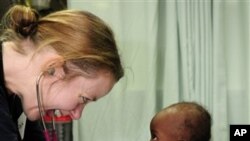More than one week after the earthquake in Haiti, patients' medical needs continue to strain resources. Since the arrival of the U.S. Navy hospital ship Comfort on Tuesday, medical staff have received more than 250 patients, performed more than 100 surgeries and evacuated two burn victims to Miami, Florida for treatment. The dedication of international volunteers and the strength of the Haitian spirit are proving to be as great as the devastation they are facing.
They sing. Some twenty female members of the surgical support staff at St. Francois de Sales hospital in Port-au-Prince sing. They sit on benches in the parking lot of the hospital, folding white gauze squares, wrapping them in brown paper to create little sterile supply kits for surgeries.
And they sing praises to the Lord for being so gracious, for looking out for them.
About 10 meters away, pergolas with thick woody vines that climb and contort provide shade for patients and impromptu places to hang intravenous drip bags.
Triage, pre-op and post-op and laboratory centers - every element of a modern hospital except the operating rooms - are outdoors under makeshift tents, ringed by the building that used to comprise this small Catholic hospital in Haiti's capital.
Doctor Jude Marie Banatte works for Catholic Relief Services. He and the organization have a long relationship with this hospital.
"Where the tents are set up, it used to be the parking lot. So this is what we are using now to make the hospital run because the patients are so scared to stay even in that part of the building that is still okay - as far as the structural engineers said that they were structurally okay - but patients don't want to stay within them because of the aftershocks," he said.
A man on a stretcher begins to breathe heavily. He is about 20 years old and just out of surgery.
The doctors are concerned. They suspect he is suffering from a pulmonary embolism, basically a blood clot in an artery of the lung that could prove fatal. They do not have the capabilities to treat this complication here. At that hour, midday Friday, the U.S. Navy hospital ship Comfort had temporarily suspended flights for incoming patients because the ship's casualty receiving department was beyond capacity.
No matter how vast the capabilities, how dedicated the sleep-deprived medics, how numerous the supplies, the medical needs in Port-au-Prince far outweigh the resources.
A Belgian doctor at St. Francois de Sales makes the decision - it is literally a matter of life and death.
Several people lift the patient's mattress from his cot and slide it into the antiquated ambulance. He is transported to a helicopter landing zone established to ferry patients to U.S. military ships for treatment. It is a risk, as the Navy doctors are not expecting this man, but there are few alternatives.
The doctors at the helicopter landing zone treat him in a tent until helicopter operations resume in the early afternoon. He is flown to the Comfort, and, as of Friday night, he is alive in the intensive care unit, in guarded condition.
Earlier in the day, back at the small hospital where the staff was singing, doctors had said they did not expect him to make it through mid-afternoon.






